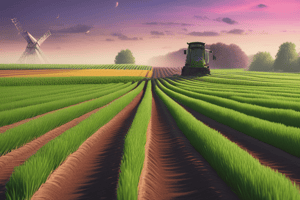Podcast
Questions and Answers
Why is crop rotation considered beneficial in agriculture?
Why is crop rotation considered beneficial in agriculture?
- To decrease soil fertility and increase pests
- To increase erosion and improve soil fertility
- To grow the same crop continuously for higher yields
- To reduce the risk of crop failure and control pests (correct)
Which type of crop is directly consumed by humans?
Which type of crop is directly consumed by humans?
- Fiber crops
- Fuel crops
- Feed crops
- Food crops (correct)
What are fiber crops primarily used for?
What are fiber crops primarily used for?
- Animal feed
- Energy production
- Textiles (correct)
- Direct human consumption
Why is it important to grow different types of crops in the same land?
Why is it important to grow different types of crops in the same land?
Which type of crop is primarily used for energy production?
Which type of crop is primarily used for energy production?
What is the purpose of pest management in crop production?
What is the purpose of pest management in crop production?
What is the main purpose of irrigation in crop production?
What is the main purpose of irrigation in crop production?
Which irrigation method involves applying water below the soil surface and letting it rise to the roots of plants?
Which irrigation method involves applying water below the soil surface and letting it rise to the roots of plants?
What is the main goal of biological control in pest management?
What is the main goal of biological control in pest management?
Which method involves altering the environment to make it less hospitable to pests in pest management?
Which method involves altering the environment to make it less hospitable to pests in pest management?
What is a potential drawback of using chemical control in pest management?
What is a potential drawback of using chemical control in pest management?
Which irrigation method involves applying water as a fine spray that covers the entire field?
Which irrigation method involves applying water as a fine spray that covers the entire field?
Flashcards are hidden until you start studying
Study Notes
Crop Production and Management
Crop production and management is a crucial aspect of agriculture that involves the cultivation of crops for food, feed, fuel, and fiber. It encompasses various activities, including crop rotation, types of crops, irrigation methods, and pest management.
Crop Rotation
Crop rotation is a farming practice that involves a regular sequence of planting different crops in the same land. This practice helps maintain soil fertility, control pests, and reduce the risk of crop failure. Crop rotation can also improve the soil's physical structure and reduce erosion. The rotation sequence varies depending on the location and the type of crops grown in that area.
Types of Crops
There are four primary types of crops: food crops, feed crops, fiber crops, and fuel crops.
-
Food Crops: These are crops that are directly consumed by humans, such as cereals (like wheat, rice, and maize), fruits, vegetables, and pulses.
-
Feed Crops: These crops are used as animal feed, such as grains (like corn, barley, and sorghum), oilseeds (like soybeans and rapeseed), and forages (like grasses and legumes).
-
Fiber Crops: These crops are used for textiles, such as cotton, jute, flax, and hemp.
-
Fuel Crops: These crops are used to produce energy, such as sugarcane, sweet sorghum, and various oil crops (like palm, soybean, canola, and corn) for biodiesel and ethanol.
Irrigation Methods
Irrigation is the process of supplying water to crops from sources outside the soil. There are several irrigation methods used in crop production:
-
Surface Irrigation: Water is applied to the surface of the land and then infiltrates into the soil. This method includes furrow irrigation and border irrigation.
-
Subsurface Irrigation: Water is applied below the soil surface and then rises to the roots of the plants. This method includes subsurface drip irrigation and capillary irrigation.
-
Sprinkler Irrigation: Water is applied as a fine spray that covers the entire field. This method includes spray irrigation, sprinklers, and micro-sprinklers.
Pest Management
Pest management involves controlling pests (insects, diseases, and weeds) that can damage crops. There are several methods used in pest management:
-
Cultural Practices: This includes crop rotation, crop selection, and altering the environment to make it less hospitable to pests.
-
Biological Control: This involves using natural enemies of pests, such as predators, parasites, and pathogens, to control pest populations.
-
Chemical Control: This involves using pesticides, herbicides, and fungicides to control pests. However, this method has the potential to harm beneficial insects and other non-target organisms, and can also contaminate the environment.
In conclusion, crop production and management is a complex process that involves various factors, including crop rotation, types of crops, irrigation methods, and pest management. Proper management of these factors can lead to increased crop yield, improved soil health, and reduced environmental impact.
Studying That Suits You
Use AI to generate personalized quizzes and flashcards to suit your learning preferences.




